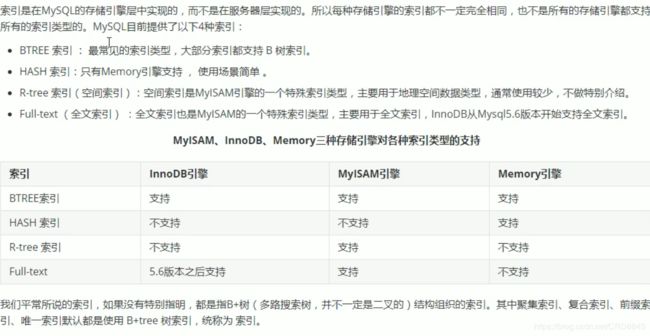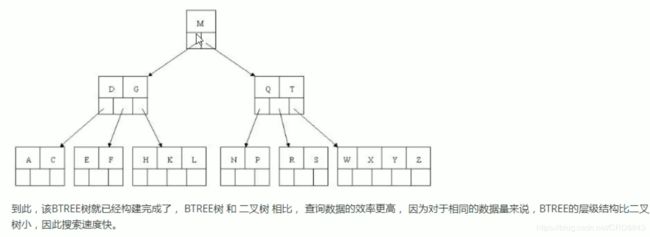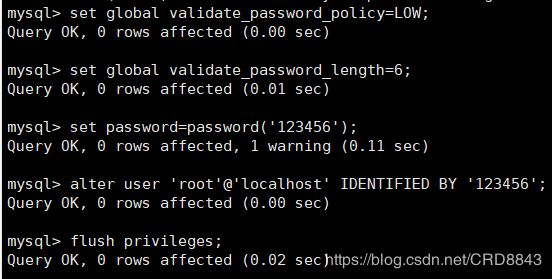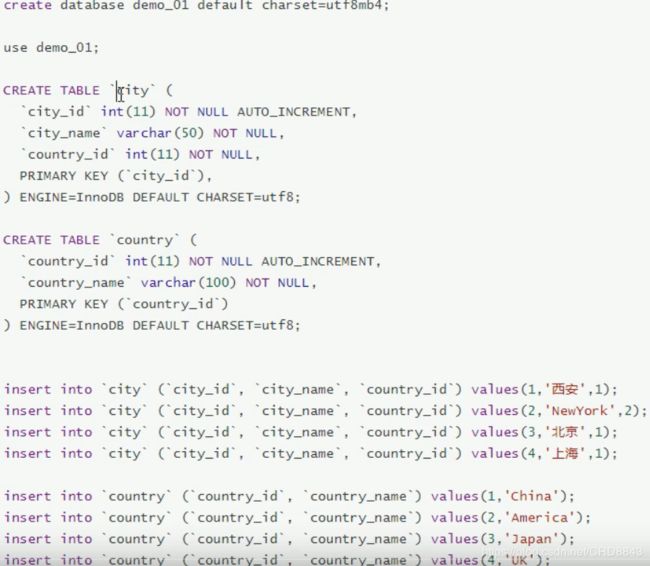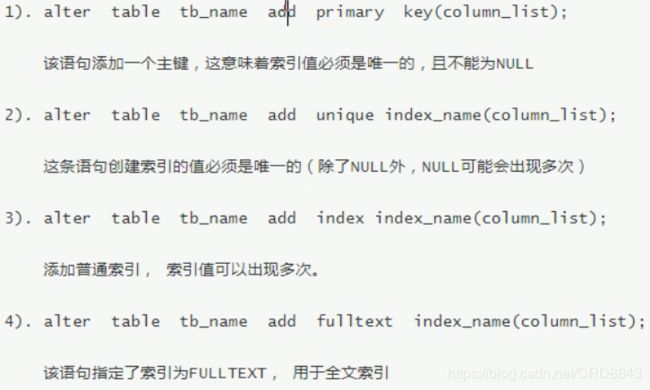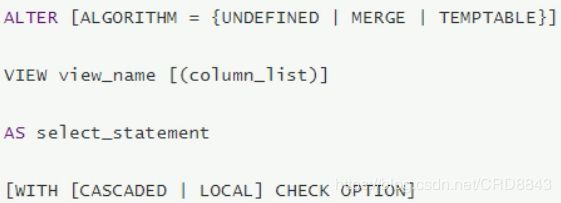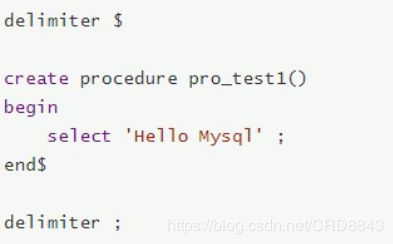数据库高级部分索引,视图,存储函数
linux下的mysql安装(非安装包下载)
详情见博客点此查看
索引概述
![]()

其实上面只是二叉树,实际上这里不是二叉树是b+tree的话其实每层之间的节点还有链表指针不仅有了平衡二叉树(这个说法是实验室说法应该说b树,但是平衡二叉树基本的特点需要了解,就能明白右边这个树为什么这样画)的功能,还有了链表相关的功能,而且这树中序遍历是按照顺序排好的
![]()
为什么有第二种数据结构来创建索引,因为第一个可以看作是一个表查询某个字段的行信息只能是自上而下的遍历查询效率很低,整表扫描
所以根据这个图假设我们查找Col2==3
图一:需要查找7次
图二:需要查找3次,34-5-3
索引优缺点
索引结构
首先要知道什么是m阶Btree数据结构是怎样的科班的可能能够理解,不理解的话跳过下面部分):
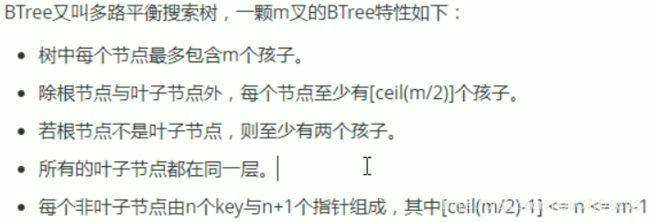
演变过程比较复杂我不做叙述自行百度了解,我只叙述原则,附上一个列子大家尝试自行推导
列:以5阶btree为列
需要知道为什么不使用二叉树,这里使用二叉树的缺点是什么
了解了btree后继续看btree的变种b+tree

附上图理解:
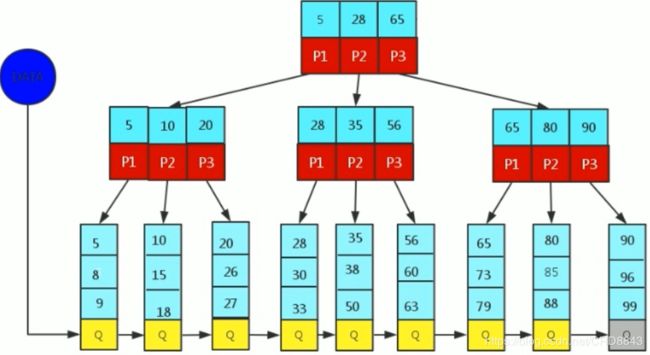
![]()
了解后继续看mysql中的索引结构,又在b+tree上做了优化,也就是我文章前面提到的情况
![]()
列:
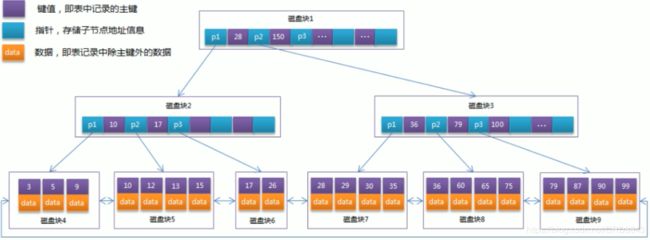
索引分类
索引语法
本人在使用数据库前遇到了一个错误
You must reset your password using ALTER USER statement before executing this statement.
然后重新登录
- 创建索引的基本语法:
列如:在这里我们为city_name创建索引
create index idx_city_name on city(city_name);
索引设计原则
- 查询频次较高,且数据量比较大的表建立索引
- 索引字段的选择,最佳候选列应当从where子句中提取,如果where组合较多,挑选最常用,过滤效果最好的列组合
- 使用唯一索引,区分度越高,使用效率越高
- 索引不是越多越好,索引数据结构维护的代价也很高,mysql选择也会发生困难
- 使用短索引,索引创建后是用磁盘存储的,加入构成索引的字段总长度比较短,那么给定大小的存储块内可以存储更多的索引值,提升mysql访问索引的io效率
- 利用最左前缀,N个列组合而成的组合索引,相当于创建了N个索引,如果查询的where子句中使用了组成该索引的前几个字段,那么这条查询sql可以利用组合索引提高查询效率
创建复合索引:
create index idx_name_email_status
on table_seller(Name,email,status);
相当于:
对name
对name,email
对name,email,status分别创建了索引
视图
- 视图概述
通俗的讲,视图就是一条select语句执行后的结果集 - 视图相对于普通表的优势
1)简单:使用视图的用户完全不需要关心后面对应的表的结构,关联条件和筛选条件,对于用户来说已经是过滤好的复合条件的结果集
2)安全:使用视图的用户只能访问他们允许的结果集,对表的权限不能限制到某行某列,但是通过视图就能够简单实现
3)数据独立:一但视图的结构确定了,可以屏蔽表结构变化对用户的影响,源表增加对视图没有影响,源表修改列名,则可以通过修改视图来解决,不会造成对访问者的影响
列:
创建一个city_country_view视图
create or replace view city_country_view
as
select ..................;
查询视图
select *from city_country_view;
show tables;能够查看到我们创建的视图show views;不起作用
存储过程和函数
4.3 调用存储过程
call procedure_name() ;
4.4 查看存储过程
-- 查询db_name数据库中的所有的存储过程
select name from mysql.proc where db='db_name';
-- 查询存储过程的状态信息
show procedure status;
-- 查询某个存储过程的定义
show create procedure test.pro_test1 \G;
4.5 删除存储过程
DROP PROCEDURE [IF EXISTS] sp_name ;
4.6 语法
存储过程是可以编程的,意味着可以使用变量,表达式,控制结构 , 来完成比较复杂的功能。
4.6.1 变量
- DECLARE
通过 DECLARE 可以定义一个局部变量,该变量的作用范围只能在 BEGIN…END 块中。
DECLARE var_name[,...] type [DEFAULT value]
示例 :
delimiter $
create procedure pro_test2()
begin
declare num int default 5;
select num+ 10;
end$
delimiter ;
- SET
直接赋值使用 SET,可以赋常量或者赋表达式,具体语法如下:
SET var_name = expr [, var_name = expr] ...
示例 :
DELIMITER $
CREATE PROCEDURE pro_test3()
BEGIN
DECLARE NAME VARCHAR(20);
SET NAME = 'MYSQL';
SELECT NAME ;
END$
DELIMITER ;
也可以通过select … into 方式进行赋值操作 :
DELIMITER $
CREATE PROCEDURE pro_test5()
BEGIN
declare countnum int;
select count(*) into countnum from city;
select countnum;
END$
DELIMITER ;
4.6.2 if条件判断
语法结构 :
if search_condition then statement_list
[elseif search_condition then statement_list] ...
[else statement_list]
end if;
需求:
根据定义的身高变量,判定当前身高的所属的身材类型
180 及以上 ----------> 身材高挑
170 - 180 ---------> 标准身材
170 以下 ----------> 一般身材
示例 :
delimiter $
create procedure pro_test6()
begin
declare height int default 175;
declare description varchar(50);
if height >= 180 then
set description = '身材高挑';
elseif height >= 170 and height < 180 then
set description = '标准身材';
else
set description = '一般身材';
end if;
select description ;
end$
delimiter ;
4.6.3 传递参数
语法格式 :
create procedure procedure_name([in/out/inout] 参数名 参数类型)
...
IN : 该参数可以作为输入,也就是需要调用方传入值 , 默认
OUT: 该参数作为输出,也就是该参数可以作为返回值
INOUT: 既可以作为输入参数,也可以作为输出参数
IN - 输入
需求 :
根据定义的身高变量,判定当前身高的所属的身材类型
示例 :
delimiter $
create procedure pro_test5(in height int)
begin
declare description varchar(50) default '';
if height >= 180 then
set description='身材高挑';
elseif height >= 170 and height < 180 then
set description='标准身材';
else
set description='一般身材';
end if;
select concat('身高 ', height , '对应的身材类型为:',description);
end$
delimiter ;
OUT-输出
需求 :
根据传入的身高变量,获取当前身高的所属的身材类型
示例:
create procedure pro_test5(in height int , out description varchar(100))
begin
if height >= 180 then
set description='身材高挑';
elseif height >= 170 and height < 180 then
set description='标准身材';
else
set description='一般身材';
end if;
end$
调用:
call pro_test5(168, @description)$
select @description$
小知识
@description : 这种变量要在变量名称前面加上“@”符号,叫做用户会话变量,代表整个会话过程他都是有作用的,这个类似于全局变量一样。
@@global.sort_buffer_size : 这种在变量前加上 “@@” 符号, 叫做 系统变量
4.6.4 case结构
语法结构 :
方式一 :
CASE case_value
WHEN when_value THEN statement_list
[WHEN when_value THEN statement_list] ...
[ELSE statement_list]
END CASE;
方式二 :
CASE
WHEN search_condition THEN statement_list
[WHEN search_condition THEN statement_list] ...
[ELSE statement_list]
END CASE;
需求:
给定一个月份, 然后计算出所在的季度
示例 :
delimiter $
create procedure pro_test9(month int)
begin
declare result varchar(20);
case
when month >= 1 and month <=3 then
set result = '第一季度';
when month >= 4 and month <=6 then
set result = '第二季度';
when month >= 7 and month <=9 then
set result = '第三季度';
when month >= 10 and month <=12 then
set result = '第四季度';
end case;
select concat('您输入的月份为 :', month , ' , 该月份为 : ' , result) as content ;
end$
delimiter ;
4.6.5 while循环
语法结构:
while search_condition do
statement_list
end while;
需求:
计算从1加到n的值
示例 :
delimiter $
create procedure pro_test8(n int)
begin
declare total int default 0;
declare num int default 1;
while num<=n do
set total = total + num;
set num = num + 1;
end while;
select total;
end$
delimiter ;
4.6.6 repeat结构
有条件的循环控制语句, 当满足条件的时候退出循环 。while 是满足条件才执行,repeat 是满足条件就退出循环。
语法结构 :
REPEAT
statement_list
UNTIL search_condition
END REPEAT;
需求:
计算从1加到n的值
示例 :
delimiter $
create procedure pro_test10(n int)
begin
declare total int default 0;
repeat
set total = total + n;
set n = n - 1;
until n=0
end repeat;
select total ;
end$
delimiter ;
4.6.7 loop语句
LOOP 实现简单的循环,退出循环的条件需要使用其他的语句定义,通常可以使用 LEAVE 语句实现,具体语法如下:
[begin_label:] LOOP
statement_list
END LOOP [end_label]
如果不在 statement_list 中增加退出循环的语句,那么 LOOP 语句可以用来实现简单的死循环。
4.6.8 leave语句
用来从标注的流程构造中退出,通常和 BEGIN … END 或者循环一起使用。下面是一个使用 LOOP 和 LEAVE 的简单例子 , 退出循环:
delimiter $
CREATE PROCEDURE pro_test11(n int)
BEGIN
declare total int default 0;
ins: LOOP
IF n <= 0 then
leave ins;
END IF;
set total = total + n;
set n = n - 1;
END LOOP ins;
select total;
END$
delimiter ;
4.6.9 游标/光标
游标是用来存储查询结果集的数据类型 , 在存储过程和函数中可以使用光标对结果集进行循环的处理。光标的使用包括光标的声明、OPEN、FETCH 和 CLOSE,其语法分别如下。
声明光标:
DECLARE cursor_name CURSOR FOR select_statement ;
OPEN 光标:
OPEN cursor_name ;
FETCH 光标:
FETCH cursor_name INTO var_name [, var_name] ...
CLOSE 光标:
CLOSE cursor_name ;
示例 :
初始化脚本:
create table emp(
id int(11) not null auto_increment ,
name varchar(50) not null comment '姓名',
age int(11) comment '年龄',
salary int(11) comment '薪水',
primary key(`id`)
)engine=innodb default charset=utf8 ;
insert into emp(id,name,age,salary) values(null,'金毛狮王',55,3800),(null,'白眉鹰王',60,4000),(null,'青翼蝠王',38,2800),(null,'紫衫龙王',42,1800);
-- 查询emp表中数据, 并逐行获取进行展示
create procedure pro_test11()
begin
declare e_id int(11);
declare e_name varchar(50);
declare e_age int(11);
declare e_salary int(11);
declare emp_result cursor for select * from emp;
open emp_result;
fetch emp_result into e_id,e_name,e_age,e_salary;
select concat('id=',e_id , ', name=',e_name, ', age=', e_age, ', 薪资为: ',e_salary);
fetch emp_result into e_id,e_name,e_age,e_salary;
select concat('id=',e_id , ', name=',e_name, ', age=', e_age, ', 薪资为: ',e_salary);
fetch emp_result into e_id,e_name,e_age,e_salary;
select concat('id=',e_id , ', name=',e_name, ', age=', e_age, ', 薪资为: ',e_salary);
fetch emp_result into e_id,e_name,e_age,e_salary;
select concat('id=',e_id , ', name=',e_name, ', age=', e_age, ', 薪资为: ',e_salary);
fetch emp_result into e_id,e_name,e_age,e_salary;
select concat('id=',e_id , ', name=',e_name, ', age=', e_age, ', 薪资为: ',e_salary);
close emp_result;
end$
通过循环结构 , 获取游标中的数据 :
DELIMITER $
create procedure pro_test12()
begin
DECLARE id int(11);
DECLARE name varchar(50);
DECLARE age int(11);
DECLARE salary int(11);
DECLARE has_data int default 1;
DECLARE emp_result CURSOR FOR select * from emp;
DECLARE EXIT HANDLER FOR NOT FOUND set has_data = 0;
open emp_result;
repeat
fetch emp_result into id , name , age , salary;
select concat('id为',id, ', name 为' ,name , ', age为 ' ,age , ', 薪水为: ', salary);
until has_data = 0
end repeat;
close emp_result;
end$
DELIMITER ;
4.7 存储函数
语法结构:
CREATE FUNCTION function_name([param type ... ])
RETURNS type
BEGIN
...
END;
案例 :
定义一个存储过程, 请求满足条件的总记录数 ;
delimiter $
create function count_city(countryId int)
returns int
begin
declare cnum int ;
select count(*) into cnum from city where country_id = countryId;
return cnum;
end$
delimiter ;
调用:
select count_city(1);
select count_city(2);

